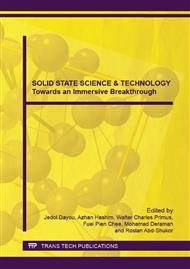[1]
L.L. Hench, R.J. Splinter, W.C. Allen, & T.K. Greenle, Bonding mechanisms at the interface of ceramic prosthetic materials, Journal of Biomedical Materials Research. 5(6) (1971) 117-141.
DOI: 10.1002/jbm.820050611
Google Scholar
[2]
A. Lucas Girot, F.Z. Mezahi, M. Mami, H. Oudadesse,A. Harabi, & M.L. Floch, Sol-gel synthesis of a new composition of bioactive glass in the quartenary system SiO2-CaO-Na2O-P2O5 : Comparison with melting method, Journal of Non-Crystalline Solids. 357 (2011).
DOI: 10.1016/j.jnoncrysol.2011.06.002
Google Scholar
[3]
E. Gentleman, Y.C. Fredholm, G. Jell, N. Lotfibakhshaiesh, M.D. O'Donnell, R.G. Hill, & M.M. Stevens, The effects of strontium- substitute bioactive glasses on osteoblasts in vitro, Biomaterials. 31(1971) 3949-3956.
DOI: 10.1016/j.biomaterials.2010.01.121
Google Scholar
[4]
Q.Z. Chen, Y. Li, L.Y. Jin, J.M.W. Quinn, & P.A. Komesaroff, A new sol-gel process for producing Na2O-containing bioactive glass ceramics, Acta Biomaterialia. 6 (2010) 4143-4153.
DOI: 10.1016/j.actbio.2010.04.022
Google Scholar
[5]
W. Xia and J. Chang, Preparation and characterization of nano-bioactive glasses (NBG) by a quick alkali-mediated sol-gel method, Material Letter. 61 (2006) 3251-3253.
DOI: 10.1016/j.matlet.2006.11.048
Google Scholar
[6]
Z. Hong, A. Liu, L. Chen, X. Chen, and X. Jing, Preparation of bioactive glass ceramic nanoparticles by combination of sol-gel and coprecipitation method, Journal of Non-Crystalline Solids. 355 (2009) 368-372.
DOI: 10.1016/j.jnoncrysol.2008.12.003
Google Scholar
[7]
A.M. El-Kady, and A.F. Ali, Fabrication and Characterization of ZnO modified bioactive glass nanoparticles, Ceramics international. 38 (2011) 1195-1204.
DOI: 10.1016/j.ceramint.2011.07.069
Google Scholar
[8]
A. Goel, R.R. Rajagobal, & J.M.F. Ferreira, Influence of strontium on structure, sintering and biodegradation behavior of CaO–MgO–SrO–SiO2–P2O5–CaF2 glasses, Acta Biomaterialia. 7 (2011) 4071–4080.
DOI: 10.1016/j.actbio.2011.06.047
Google Scholar
[9]
H.F. Ko, Design, Synthesis, and Optimization of Nanostructured Calcium Phosphates (NanoCaPs) and Natural Polymer Based 3-D Non-viral Gene Delivery Systems, ProQuest LLC, Michigan, (2009).
Google Scholar
[10]
M.D. O'Donnell, P.L. Candarlioglu, C.A. Miller, E. Gentleman, & M.M. Stevens, Materials characterisation and cytotoxic assessment of strontium-substituted bioactive glasses for bone regeneration, Journal of Materials Chemistry. 20(40) (2010).
DOI: 10.1039/c0jm01139h
Google Scholar
[11]
L.L. Hench, Bioceramics –from concept to clinic, Journal of the American Ceramic Society. 74 (1991) 1487-1510.
DOI: 10.1111/j.1151-2916.1991.tb07132.x
Google Scholar


